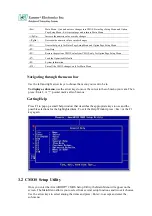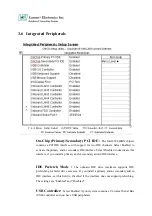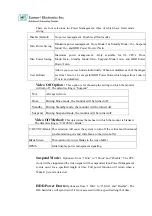
Virus Warning:
The default setting of Virus Warning is “Disabled”. When it is
enabled, any attempt to write the boot sector and partition table will halt the system and
cause a warning message to appear. If this happens, you can use an anti-virus utility on
a virus free, bootable floppy diskette to reboot, to clean and to investigate your system.
Quick Power On Self Test :
The default setting is “Enabled”. This speeds up
the Power On Self Test (POST) by skipping some items that are normally checked
during the full POST. If your system is functioning normally, you can choose this
feature to speed up the booting process.
First / Second / Third / Other Boot Device :
The BIOS attempts to load
the operating system from the devices in the sequence selected in these items. The
settings are Floppy, LS/ZIP, HDD-0/HDD-1/HDD-2/HDD-3, SCSI, CDROM, LAN,
and Disabled
Swap Floppy Drive :
The default setting is “Disabled”. This setting gives you an
option to swap A and B floppy disks. Normally, the floppy drive A is the one at the end
of the cable and drive B is at the other end. If you set this option to “Enabled”, the Drive
A will function as Drive B, and vice-versa under the DOS.
Floppy Disk Access Control:
This option specifies the read/write access that is
set when booting from a Floppy disk drive. The settings are Read/Write or Read-Only.
The Optimal and Fail-Safe default settings are Read/Write.
Boot Up Numlock Status :
The default setting is “On”. If set “Off”, the cursor
controls will function on the numeric keypad.
Security Option :
This setting controls the password in the main screen. The
options are “Setup” and “System”. Select “Setup” and it will protect the Setup Utility
settings from being tampered with. Select “System” if you want to use password feature
every time the system boots up. The default setting is “Setup”. You can create your
password by using the “SUPERVISOR/USER PASSWORD” utility on the main
program screen.




































